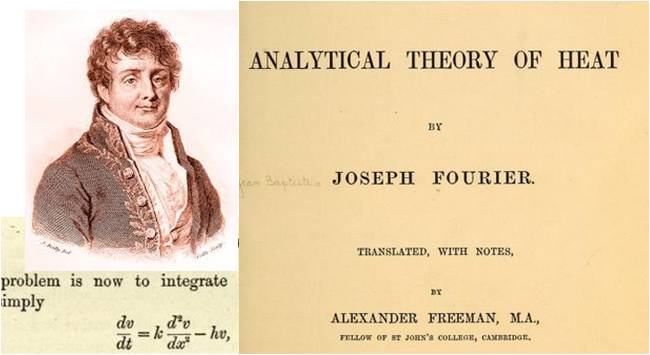The Analytical Theory of Heat
In 1822 Fourier published his work on heat flow in Théorie analytique de la chaleur (The Analytic Theory of Heat), in which he based his reasoning on Newton's law of cooling, namely, that the flow of heat between two adjacent molecules is proportional to
the extremely small difference of their temperatures. This book was translated, with editorial 'corrections', into English 56 years later by Freeman (1878). The book was also edited, with many editorial corrections, by Darboux and republished in French in 1888.
There were three important contributions in this work, one purely mathematical, two essentially physical. In mathematics, Fourier claimed that any function of a variable, whether continuous or discontinuous, can be expanded in a series of sines of multiples of the variable.
Though this result is not correct without additional conditions, Fourier's observation that some discontinuous functions are the sum of infinite series was a breakthrough.
One important physical contribution in the book was the concept of dimensional homogeneity in equations; i.e. an equation can be formally correct only if the dimensions match on either side of the equality; Fourier made important contributions to dimensional analysis.
The other physical contribution was Fourier's proposal of his partial differential equation for conductive diffusion of heat.
(from wikipedia.org)
 |
| e-Books |
| The Analytical Theory of heat By Joseph Fourier, 1768-1830; translated with notes by Alexander Freeman. Topics: Heat. Publisher: Cambridge [Eng.] University Press. Book Contributor: Wellesley College Library. |
| The Analytical Theory of Heat By Joseph Fourier, 1768-1830; translated with notes by Alexander Freeman. Topics: Heat. Publisher: Cambridge [Eng.] University Press. Book Contributor: University of California Libraries. |
| The Analytical Theory of Heat By Joseph Fourier. Translated with notes by Alexander Freeman. The text of this work is in the "Public Domain" in Australia. Table of Contents. 1. Introduction. 2. Equation of the Movement of Heat. ... |